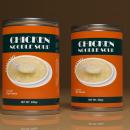How do you know if you're getting a good deal?
Sometimes similar foods are sold in different sizes, which can make it hard to compare prices. Unit pricing is a way to compare similar products to determine which is the best deal. Instead of focusing only on the overall price, with unit pricing you calculate the cost of a “unit” of that product, which could be per serving, ounce or pound for a few examples.

Let’s see how this works by comparing two cans of chicken noodle soup. The first can is 19 ounces and costs $2.69. The second can is 10.5 ounces and costs $1.99. The second may be the lower price, but is it the best deal? The chart below breaks down the unit price for each can.
| Can 1 | Can 2 | |
|---|---|---|
| Price | $2.69 | $1.99 |
| Unit size | 19 ounces | 10.5 ounces |
| Price per unit | $0.14 per ounce | $0.19 per ounce |
Per ounce, the first can costs less than the second can! Most of the time, larger packages tend to cost less per unit than smaller packages. That’s the better deal, if you are going to eat the whole package before it goes bad. For some foods, buying bigger may not be better if you end up throwing half of it out. Only you know what will work for you and your family.
Fresh produce
When shopping the produce section, start by reading the shelf sticker: is it priced per piece or by the pound?
Which is the better buy? Let’s compare these peppers and find out.

To compare the best price between piece or pound, grab your phone and plug this in:
By item:
- Weigh the item in Pounds. This green pepper weighs 0.3 pounds.
- Divide the price by the weight to get the price per pound. So, divide .99 by .3 to find that green peppers cost $3.30 per pound.
By Pound:
- Weigh the item by piece. These peppers weigh .25 pounds.
- Multiply the weight by price to get the price of the piece. So, take .25 x 4.8 to find this pepper costs $1.20.
The mix of bell peppers looks a lot more expensive, and when you calculate the cost, it is $0.21 more than the green pepper. The green pepper is the better buy.
Packaged products
Which of these is the best deal?

If you guessed Salad Dressing 2 you’re right!
The price per ounce is found by dividing the cost of the item by the number of ounces.
- Salad Dressing 1 costs $3.89 for 32 ounces. For this dressing, divide $3.89 by 32 to get $0.12.
- Salad Dressing 2 costs $4.29 for 48 ounces. For this dressing, divide $4.29 by 48 to get $0.09.
Most grocery store shelf labels have the price per ounce posted so you can compare unit prices without a calculator.
Other tips for finding the best deals
End-caps may display items that are advertised as “specials,” but check the price because it may be the regular price (or even marked up).
Shop the upper and lower shelves in each aisle. Items at eye level are placed there to make the product more enticing although it may not be the healthiest or least expensive option.